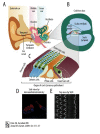Inner ear symptoms and disease: pathophysiological understanding and therapeutic options
- PMID: 24362017
- PMCID: PMC3872449
- DOI: 10.12659/MSM.889815
Inner ear symptoms and disease: pathophysiological understanding and therapeutic options
Abstract
In recent years, huge advances have taken place in understanding of inner ear pathophysiology causing sensorineural hearing loss, tinnitus, and vertigo. Advances in understanding comprise biochemical and physiological research of stimulus perception and conduction, inner ear homeostasis, and hereditary diseases with underlying genetics. This review describes and tabulates the various causes of inner ear disease and defines inner ear and non-inner ear causes of hearing loss, tinnitus, and vertigo. The aim of this review was to comprehensively breakdown this field of otorhinolaryngology for specialists and non-specialists and to discuss current therapeutic options in distinct diseases and promising research for future therapies, especially pharmaceutic, genetic, or stem cell therapy.
Figures

Similar articles
-
Current status and prospects of gene therapy for the inner ear.Hum Gene Ther. 2011 Nov;22(11):1311-22. doi: 10.1089/hum.2010.246. Epub 2011 May 19. Hum Gene Ther. 2011. PMID: 21338273 Free PMC article. Review.
-
Organoids-the key to novel therapies for the inner ear?HNO. 2024 Dec;72(Suppl 2):83-88. doi: 10.1007/s00106-023-01367-x. Epub 2024 May 22. HNO. 2024. PMID: 38775829 Review. English.
-
[Gene therapy and stem cells for the inner ear: a review].HNO. 2014 Feb;62(2):93-9. doi: 10.1007/s00106-013-2822-0. HNO. 2014. PMID: 24549508 Review. German.
-
Gene transfer in inner ear cells: a challenging race.Gene Ther. 2013 Mar;20(3):237-47. doi: 10.1038/gt.2012.51. Epub 2012 Jun 28. Gene Ther. 2013. PMID: 22739386 Review.
-
Outlook and future of inner ear therapy.Hear Res. 2018 Oct;368:127-135. doi: 10.1016/j.heares.2018.05.009. Epub 2018 May 17. Hear Res. 2018. PMID: 29804723 Free PMC article. Review.
Cited by
-
Exploring the Significance of Vitamin D Levels as a Biomarker in Ear Diseases: A Narrative Review.Cureus. 2024 Feb 24;16(2):e54812. doi: 10.7759/cureus.54812. eCollection 2024 Feb. Cureus. 2024. PMID: 38529449 Free PMC article. Review.
-
Chronic pulsatile tinnitus and continuous vertigo due to very delayed diagnosis of single slow-flow dural arteriovenous.J Neurosci Rural Pract. 2023 Jan-Mar;14(1):140-142. doi: 10.25259/JNRP_35_2022. Epub 2022 Dec 15. J Neurosci Rural Pract. 2023. PMID: 36891096 Free PMC article.
-
Integrating Cupping Therapy in the Management of Sudden Sensorineural Hearing Loss: A Case Report.Cureus. 2020 Feb 20;12(2):e7063. doi: 10.7759/cureus.7063. Cureus. 2020. PMID: 32226665 Free PMC article.
-
Otorhinolaryngological adverse effects of urological drugs.Int Braz J Urol. 2021 Jul-Aug;47(4):747-752. doi: 10.1590/S1677-5538.IBJU.2021.99.06. Int Braz J Urol. 2021. PMID: 33566468 Free PMC article. Review.
-
The Use of Human Mesenchymal Stem Cells as Therapeutic Agents for the in vivo Treatment of Immune-Related Diseases: A Systematic Review.Front Immunol. 2018 Sep 11;9:2056. doi: 10.3389/fimmu.2018.02056. eCollection 2018. Front Immunol. 2018. PMID: 30254638 Free PMC article.
References
-
- Ménière P. Pathologie auriculaire: memoire sur des lesions de l’oreille interne donant lieu a des symptomes de congestion cerebrale apoplectiforme. Gaz Med. 1861;16:597–601. [in French]
-
- Chung DY, Gannon RP, Mason K. Factors affecting the prevalence of tinnitus. Audiology. 1984;23(5):441–52. - PubMed
-
- National Center for Health Statistics. Vital and Health Statistics, Series 11 No. 32. 1968. pp. 1–28. - PubMed
-
- Nadol JB., Jr Hearing loss. N Engl J Med. 1993;329:1092–102. - PubMed
Publication types
MeSH terms
LinkOut - more resources
Full Text Sources
Other Literature Sources
Medical

